It is always fascinating to see how other people live or to speculate how our ancestors went about their daily lives. The foods they eat, how they care for their children, and their basic everyday activities can tell us quite a bit about them. Today we’re getting a glimpse into Native American life from 150 years ago.
F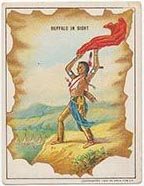 or the Native Americans, the herds of buffalo were one of the most important resources they had. In addition to meat, the animals provided them with clothing, shelter, and trade items.
or the Native Americans, the herds of buffalo were one of the most important resources they had. In addition to meat, the animals provided them with clothing, shelter, and trade items.
Buffalo in Sight ~ One scout would be sent to the top of a hill neighboring the camp to act as a lookout for the buffalo herd. When the animals were sighted, the scout started waving a blanket to signal the camp.
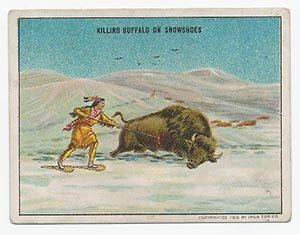 Killing Buffalo on Snowshoes ~ Heavy snows put them on a more even footing with the large buffalo, allowing them to spear the animal.
Killing Buffalo on Snowshoes ~ Heavy snows put them on a more even footing with the large buffalo, allowing them to spear the animal.
By donning snowshoes, the hunter was able to stay on top of the snow even as the buffalo sank through it.
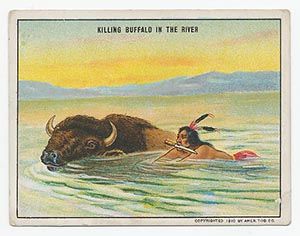 Killing Buffalo in the River ~ The Native Americans were adaptable and courageous when hunting, using various skills including swimming. They often managed to kill a buffalo by swimming next to it as it crossed a river.
Killing Buffalo in the River ~ The Native Americans were adaptable and courageous when hunting, using various skills including swimming. They often managed to kill a buffalo by swimming next to it as it crossed a river.
Using only their knife, they would cut its throat and then depend on their own swimming ability to stay out of its way as it weakened.
Related: Lost Native American Survival Skills
Life was full of danger for the Native Americans. They battled nature and the damage it could inflict as well as always trying to keep other tribes from stealing their horses, women, and food.
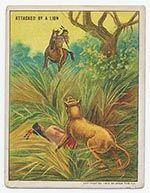 Attacked By a Lion ~ The hunter often became the hunted when dealing with a mountain lion. These wily cats were known by different names depending on what part of the country they lived in – puma, panther, and catamount.
Attacked By a Lion ~ The hunter often became the hunted when dealing with a mountain lion. These wily cats were known by different names depending on what part of the country they lived in – puma, panther, and catamount.
These big cats wrought havoc on prey animals such as cattle, sheep, and goats. The risk they posed to the horse herds along with the value of their skins were just two of the reasons they hunted them.
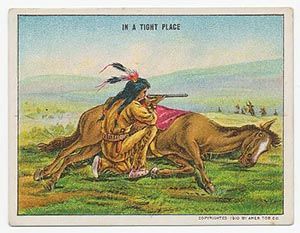 In a Tight Place ~ Superior numbers of hostile tribes were a constant threat. A lone scout out in the open could depend on his horse to help protect him.
In a Tight Place ~ Superior numbers of hostile tribes were a constant threat. A lone scout out in the open could depend on his horse to help protect him.
These horses were trained to lay down quietly and provide a living shield for his master.
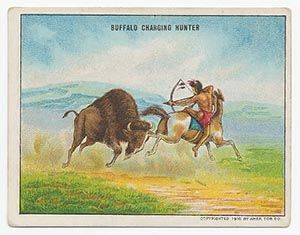 Buffalo Charging Hunter ~ Hostile tribes weren’t the only thing that charged at or tried to run down the brave Natives. Large buffalo cows and bulls could turn from prey to hunter in a moment’s notice.
Buffalo Charging Hunter ~ Hostile tribes weren’t the only thing that charged at or tried to run down the brave Natives. Large buffalo cows and bulls could turn from prey to hunter in a moment’s notice.
Once again, the well-trained and lightning-fast horses came to the rescue. As the hunter was only armed with a bow and arrow, it was necessary for the agile horses to get them close enough for the kill but to also keep them out of harm’s way.
Native Americans used boats for more than just fishing. As their skills grew, so did the purposes and types of their watercraft.
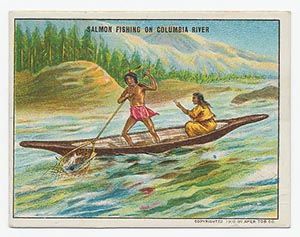 Salmon Fishing on Columbia River ~ Contrary to popular belief, not all canoes or boats built by the Native Americans were made from the bark of birch trees.
Salmon Fishing on Columbia River ~ Contrary to popular belief, not all canoes or boats built by the Native Americans were made from the bark of birch trees.
Birch doesn’t grow on the banks of the Columbia River, the Natives used whatever trees were available and suitable to carve their dugouts like the one above.
Related: How Cherokees Used Trees of Southern Appalachia for Food, Medicine, and Craft
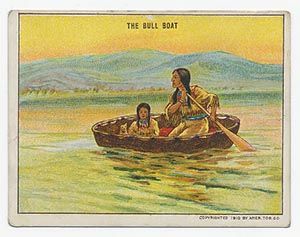 The Bull Boat ~ The bull boat is known to be one of the most primitive boats in the world and is so named because of the bull hides originally used in its making. Raw hides that have been soaked in water are stretched over a wood framework.
The Bull Boat ~ The bull boat is known to be one of the most primitive boats in the world and is so named because of the bull hides originally used in its making. Raw hides that have been soaked in water are stretched over a wood framework.
The hide was then bound in place and allowed to dry in the sun until it was as hard as bone and waterproof.
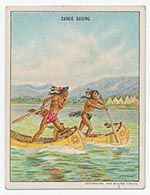 Canoe Racing ~ Crafting canoes was a skill in which many Native Americans excelled.
Canoe Racing ~ Crafting canoes was a skill in which many Native Americans excelled.
The canoes were quite fragile while being strong and sturdy at the same time.
Young tribesmen enjoyed racing their craft to show off their abilities.
Horses were a vital part of daily life for Native Americans. Transportation, hunting, trading, and even food were some of what horses offered the tribes.
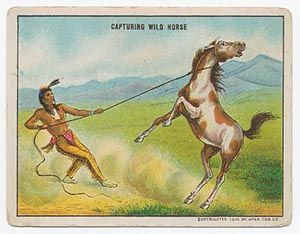 Capturing a Wild Horse ~ While the Natives were expert horsemen, they weren’t in the business of breeding horses. The replenished their horses on a regular basis by using their current mounts to help them capture new ones from the wild herds. Stealing horses from other tribes was also a common occurrence.
Capturing a Wild Horse ~ While the Natives were expert horsemen, they weren’t in the business of breeding horses. The replenished their horses on a regular basis by using their current mounts to help them capture new ones from the wild herds. Stealing horses from other tribes was also a common occurrence.
A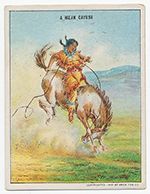 Mean Cayuse ~ Ponies or horses were also known as a cayuse or broncho. These wild horses were frequently found to be difficult to tame and train. It required extensive horsemanship skills to accomplish this, but once trained, they became a highly prized possession.
Mean Cayuse ~ Ponies or horses were also known as a cayuse or broncho. These wild horses were frequently found to be difficult to tame and train. It required extensive horsemanship skills to accomplish this, but once trained, they became a highly prized possession.
A little-known fact is that it was quite often the women who were the horse trainers. Their abilities rivaled and even surpassed those of the men at times.
A Spilt 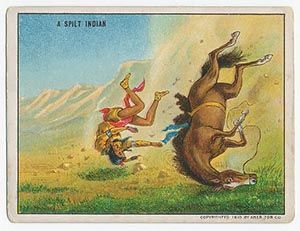 ~ Due to their excellent horsemanship and the agility of their horses, they often took risks that ended in disaster.
~ Due to their excellent horsemanship and the agility of their horses, they often took risks that ended in disaster.
Accidents were common as the riders asked their mounts to perform unsafe maneuvers.
The Native Americans were primarily hunters and gatherers. While the women took care of all of the gathering and some of the fishing, the men were expected to provide the game.
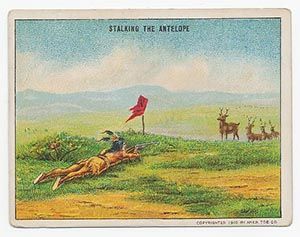 Stalking the Antelope ~ Because the antelope or pronghorn is an extremely curious creature, it is also one that easily falls prey to hunters. Their natural tendency is to investigate anything new or unusual in their surroundings.
Stalking the Antelope ~ Because the antelope or pronghorn is an extremely curious creature, it is also one that easily falls prey to hunters. Their natural tendency is to investigate anything new or unusual in their surroundings.
A common ploy was to tie a bright piece of fluttering cloth on a stake in the ground. The hunter then lay in wait for the nosy antelope to approach and become easy targets.
Related: Six Primitive Traps For Catching Game In The Woods
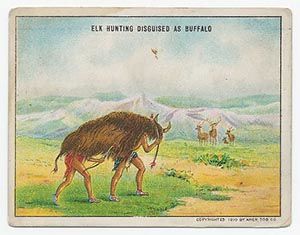 Elk Hunting Disguised as a Buffalo ~ Before they relied on the use of guns for hunting game, they had to improvise in order to get up close to the elk herds.
Elk Hunting Disguised as a Buffalo ~ Before they relied on the use of guns for hunting game, they had to improvise in order to get up close to the elk herds.
By covering themselves with a buffalo hide, they were able to creep in near enough to the animals to kill them with their bows and arrows.
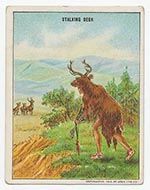 Stalking Deer ~ Similar to their method of stalking elk above, they commonly covered themselves with the head and hide of a deer in order to approach the wily animals.
Stalking Deer ~ Similar to their method of stalking elk above, they commonly covered themselves with the head and hide of a deer in order to approach the wily animals.
As their bows and arrows were ineffective from long ranges, they needed to close in on their quarry before being detected.
The medicine man and chief tended to stay in or near camp most of the time. In some tribes, they were even the same person.
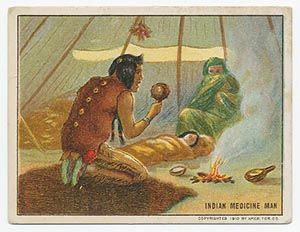 Medicine Man ~ With little to no knowledge of drugs or more modern methods of treating diseases, the Medicine Man used other ways to attempt to drive evil spirits from his patients. He relied heavily on chanting, shaking his medicine rattle, and burning sweet smelling herbs. Find out the medicinal plants the Native Americans used on a daily basis.
Medicine Man ~ With little to no knowledge of drugs or more modern methods of treating diseases, the Medicine Man used other ways to attempt to drive evil spirits from his patients. He relied heavily on chanting, shaking his medicine rattle, and burning sweet smelling herbs. Find out the medicinal plants the Native Americans used on a daily basis.
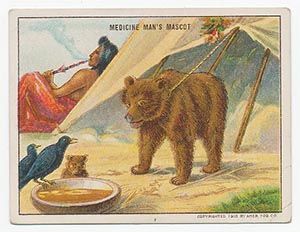 Medicine Man’s Mascot ~ The Medicine Man was widely respected for more than just his healing arts, he was also admired for the pets or mascots that he kept.
Medicine Man’s Mascot ~ The Medicine Man was widely respected for more than just his healing arts, he was also admired for the pets or mascots that he kept.
It was not unusual for him to have tamed bears, pet crows, and trained dogs.
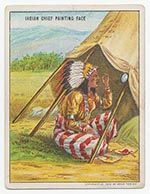 Chief Painting Face ~ Painting their bodies and faces with bright stripes of color was something the Natives did on a regular basis. In times of peace it was for decoration. While engaging in war, it was meant to distract and terrify their enemies.
Chief Painting Face ~ Painting their bodies and faces with bright stripes of color was something the Natives did on a regular basis. In times of peace it was for decoration. While engaging in war, it was meant to distract and terrify their enemies.
Carrying small mirrors or looking glasses was common as they were also used for ornament and as signaling devices.
The women were the hardest working group of the tribe. Their many responsibilities and tasks kept the camp in order and functioning. Aside from hunting and fighting, the men didn’t do much else as they thought ordinary tasks were beneath them.
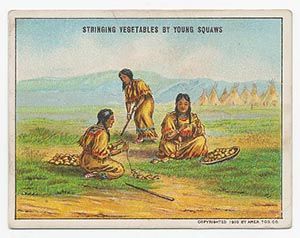 Stringing Vegetables By Young Women ~ The Native Americans didn’t do much gardening, they depended more on gathering vegetables that grew wild. One of these prized plants was known as pomblanch or white root.
Stringing Vegetables By Young Women ~ The Native Americans didn’t do much gardening, they depended more on gathering vegetables that grew wild. One of these prized plants was known as pomblanch or white root.
Once it was gathered it was strung, dried in the sun, and then pounded until it turned into a flour.
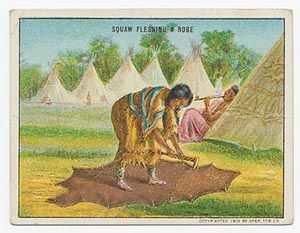 Fleshing a Robe ~ Once the hunter killed the animal, his job was done and the women was expected to do everything else. This image shows her preparing the skin as her husband lounges against the tent smoking.
Fleshing a Robe ~ Once the hunter killed the animal, his job was done and the women was expected to do everything else. This image shows her preparing the skin as her husband lounges against the tent smoking.
She will eventually either use the skin for her family or as a trade item, bartering it for sugar, flour, and possibly calico fabric at the trader’s store.
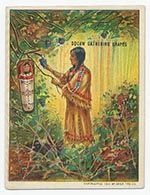 Gathering Grapes ~ It was not uncommon for the women of the tribe to travel long distances searching for wild fruits, roots, and vegetables. Grapes were a staple that they dried in preparation for winter use.
Gathering Grapes ~ It was not uncommon for the women of the tribe to travel long distances searching for wild fruits, roots, and vegetables. Grapes were a staple that they dried in preparation for winter use.
The women often took their baby or papoose with them while gathering, sometimes hanging them in their board from a branch. This allowed them to keep an eye on the baby.
So now you’ve had a chance to see what went on in a typical day in the life of a Native Americans. Would you have enjoyed that lifestyle?
You may also like:
 21 Lost Tips from 100 Years Ago – with Illustrations
21 Lost Tips from 100 Years Ago – with Illustrations
How To Make Your House Invisible To Looters (Video)
The Best 5 States for Living Off-Grid
15 Lost Survival Tips From The Cowboys Who Wandered The West – With Illustrations

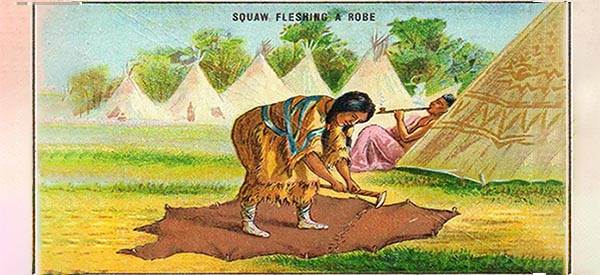













Loved the one where the guy lounges smoking a pipe and the women do all the work !! If that’s the way it would be emp hit me NOW!!!
He killed it, she cleans it. It is called shared work. The men and women had specific roles in their society
Actually the term “squaw” is a very derogatory term for an Indian women and should not be used.
That was the first thought across my mind, too. The English word is not obscene, but it IS vulgar.
These pictures were on “tobacco cards” dated early 1900s People back then were “Archie Bunkers” and hated/despised everybody who wasn’t white equally. Different times…different attitudes+beliefs….eg: if you were a member of a union back then, that made you an enemy of the state that deserved to be beaten and shot….it is due to this history that we have the attitudes we have today..
I just finished reading a book by a mountain man from the 1850s. He provides a first hand look at Indian life at least during that period of time. It was a hard scrabble life and only some tribes enjoyed the life described above. Others lived a brutish life constantly on the edge of disaster from starvation, injury or sickness. While it is his opinion of what he observed, he lived the life of a mountain trapper for 60 years and wrote the book when he was 82 years of age and still living among the Indians following the trapping trade.
The problem with comparing life after a modern day disaster with the life of our pioneers is that we had 5 million US citizens in 1800 and today we have 365 million. We had a lot of resources like land and wood for fuel to name only two, in 1800. Today we have vastly more people and far fewer resources. Don’t think you could “just live like the pioneers” unless you’re somewhere with a pioneer spirit and a small population, like possibly Alaska, or Wyoming. You’re fooling yourselves. We can’t go back.
That’s why estimates even by governmental agencies are that 90% of the population will die off in the first year after a significant event such as a EMP, CME, extensive atomic attack, or an event that destroys the electric grid.
Without modern farming and distribution techniques, the country cannot support our current population.
In addition, most of us don’t have the everyday life skills that people had in the 1800s. I have never sheared a sheep. My wife has never carded wool or spun it into yarn. I know absolutely nothing about diseases that affect horses, cows or other farm animals. My family raised chickens prior to my starting school and during WWII, but other than my limited interface with that experience, I know nothing about even raising chickens and living where I do, I don’t have the space to even raise a couple.
So, either I will have a very steep learning curve or I will be in the 90%.
In the 1800s even a farmer who plowed by hand had a plow for tilling the soil. If I want to break up the soil, I would be doing it as I saw the farmers in the Far East doing it in the early 50s, with a adze. Hard to till 40 acres that way. Heck, hard to till 1 acre that way. I don’t even have a spading fork to work the soil. That’s what my father used to break up the soil for our victory garden during WWII.
When I first moved into this house 50 years ago I rented a roto-tiller to break up the soil. Liable not to be available after at least a couple of the events I mentioned.
I have read that it takes an acre per person to raise enough food to last one year, assuming one preserves enough to last through the non-growing months. I guess I will be heavily into dandelions as they seem to grow quite well without much encouragement. Would you like a cup of hot dandelion root while we sit and visit?
I will take a fist full of the dandelion seeds, thank you. They do not grow in my lawn here in the Florida Panhandle.
Dandelions. Your neighbors are likely to severely resent any outbreak. They’d likely poisoned their way (Roundup etc.) to any current dandelion-free situation.
Dandelions are edible, but lots of stoop labor involved.
Luckily for us there are now many ways a person can grow some food even without the benefits of a small yard. I have seen food growing in barrels with holes cut in the sides so the plants are growing all over the sides and top of the barrel. Also hydroponics and aquaponics allows for food production in limited spaces. Really there is no reason to starve.
Have you actually accomplished this or is this something you have seen in catalogs from companies that sell these products?
Have you actually produced a year’s worth of food from the method you describe or have you just filled in some supplies during the summer. It’s easy to grow tomatoes to supply your salad needs for the summer, how about canning enough tomatoes to last through the winter months for spaghetti sauce and tomatoes for other dishes? How about potatoes through the winter; sweet potatoes; beans; corn; peas?
When I say an acre per person, I am not talking about supplementing your weekly groceries with fresh veggies from your aquaponics box or your whiskey barrel with some squash. I am talking about having vegetables available during the winter months when the ground is frozen solid.
Tell me that you have actually grown enough produce using the methods you suggest to last you a whole year and I will become a believer. Otherwise, I would suggest that folks who actually grow crops commercially know better and state that it takes an acre of land per person to grow enough crops to last a whole year. Certainly you can use hydroponics to grow sufficient crops provided that you have a large enough facility.
In Japan they use hydroponics to grow crops commercially, but we are talking about a greenhouse that is almost an acre in size in just one greenhouse and they have multiple greenhouses. We watch NHKTV on a daily basis and they frequently feature some farmer who is using hothouse methods to grow crop commercially and their hothouses are huge, sometimes a football field size.
You are right about the learning curve. I moved to a larger place in a drier and harsher climate than I have ever lived in about a year or so ago. I have been attempting to grow some little bits. No where near enough to live on! The weather can change dramatically in this area. During the winter we had several feet of long lasting snow. This summer we had day after day of of over 100 degrees. The best success I have had is with trellising plants next to the house where I would pay more attention to them. Then a couple of days ago, there was a huge blast of dry wind that knocked it all down. It looks like at least one plant didn’t survive the damage.
Then, there are the bugs! I see cabbage moths and other moths flying around. My grapes are full of the biggest and healthiest earwigs I have ever seen.
As far as huge hothouses go, last winter’s snow was heavier than usual so several local greenhouses and onion storage houses collapsed.
The methods shown in books are great and fun to imagine doing but, the books do not cover all contingencies. The other factor is the time involved. Unless a person has been growing awhile, they do not have efficient methods of getting the job done.
I highly recommend that people experiment today, now, even if it is a few plants in a pot or a jar with sprouts.
Left Coast Chuck, I think that you read the same book I read a bit ago, “My Sixty Years on the Plains”.
The over use of “Native Americans” almost made me not want to read this, just call them indians or only mention it once, we know who you are speaking of.
Left Cost Chuck, I am a farmer and you can grow enough food in raised beds, barrels or other containers to last a year. Provided you have enough sunlight, soil and water, all of which you can get by trapping rain water, building soil with compost etc… and you know how to preserve it properly i.e. Drying, canning and such. As for protein you’d either have to hunt for or raise it. Unless you get enough from beans and other plant based proteins. It can be done, but again you’d have to either have the knowledge already or be on a steep learning curve. Depending on the variety you can get anywhere from 1-5 lbs of potatoes from one plant, 1-3 lbs of tomatoes from one plant and so on. Be creative, and start learning now so you can be prepared.
Main article Politically Correct in terminology and illustrations.
Indian tribes at First Contact were living in regionally and climate adapted ways, mostly in hunter-gatherer clans, but some as agriculturalists. Hunter-gatherers tended to be migratory. (Aside from Arabic writing and acquired Greek sciences, 1500s to 1700s migratory Indians and pastoral Arabs were very similar. North African Berbers (Barbary Coast) continued to be thus until quite recently.)
Indian oral-culture societies had already been severely damaged by European diseases which sped through all tribes after Gulf Coast agriculturalists and fisherfolk met first Spanish explorers. Indians before had extensive trading networks along coasts and rivers. E.g., cowrie shells found on coasts got traded from hand to hand into deep interiors.
Illustrations: Indian females went about ‘topless’ just like males except in cooler weather or for ceremonial events. Both tended to wear open bolero jackets (like SE Asian Hmong) in cooler weather, and then use furs like Eskimo / Inuit during coldest months.
In days before mechanized looms, woven cloth was relatively expensive, so was reserved for ceremonial occasions. As were decorated leathers. Ordinary folk wore as little as possible during warmer weather spells, and children ran about nigh nude before puberty.
And yes, ‘squaw’ is a rude label. But its like in Hebrew occurs in Bible books describing the Israelite overrun of Canaan. (Ancients not much on PC labels.) Shan’t use the real translation here.
Of course, The Iroquois Confederacy under the Iroquois General And Commander-In-Chief Of The Continental Army Our George Washington defeated the British occupier and wrote The United States Constitution. Americans haven’t lived like these pictures or anything closely resembling them since before Freedom From The Enemy and mainly on historic reservation lands and reenactments. Legalized organized immigration of aliens from across the ocean wasn’t enacted and widespread until the late 1800s by The Gregorian Calendar. The word “squaw” is an American word, of course, which is entirely acceptable. As well, if you listen to the imported British versions of America, they won and America lost which, needless to tell any of you at this site, was never the case. I’m sure you’ve heard. You can always tell what foreign groups own and operate what media in America by how they revise history to enhance and distort their own image.
With the exception of beans and meats we used to grow most of a years food on an acre for for 6 of us. Wonderful mild climate with 11 Gardening months per year. I now live in high mountain desert with an if you’re lucky growing season 6 months long. To get ripe tomatoes you need a greenhouse because of cool nights. I still garden almost year around by coverings, greenhouse, hotbeds using glass doors and two rows of cinderblocks, indoor seedlings, winter potted transplants moved inside, and rich, fertle, raised beds. I raise chickens, ducks, and rabbits. We can, sundry, and freeze foods. I gather wild, and even grow “wild” plants with hearty constitutions. They fit the climate better. Still I don’t have a dairy, wool, or larger meat animal. We eat eggs, chickens and rabbits. Yes I grow cllimbing greenbeans but pintos make good greenbeans then dry beans later in the season. Pumpkins grow well here but Gray Hubbard keeps better. Every plant is choosen carefully. I fill all my canning jars either from my garden or saving leftovers and canning sauces and soups. We make prickly pear jelly, syrup, hard candies and usually a gallon of wine. I grow grapes on an arbor. Planted my own wild plum thicket and have started a patch of wild goose berries. I grow asparagus and rhubarb. I started mint along a water ditch where it has gone wild. Alfalfa also grows along the water ditch and I cut it fresh for all my critters, dry some for winter feed and make tea from growing tips. Saved seed makes winter sprouts. And truth be told, we are no where near self sufficient. I am not able to work that hard anymore.
Lama, alpaca, and Kashmir (cashmere source) goats do well in arid places. They mostly provide hair and meat. Lama and alpaca may wander off. Goats in general are rather destructive, so must be penned in large enclosures within high fences. They may climb trees.
Don’t slaughter such animals within sight of any others. Ducks and ungulates remember.
Horses are not native to this continent. They were Spanish imports that became very important to life and trade.
Just as in Central Asia, according to paleontologists there once were horses (Przewalski’s) and cameloids in North America. And elephantians like mammoths. Theory is, precursors to Indians hunted them to extinction.
It’s a curiosity how species survived on some continents and not others. Why no horses in Africa, yet zebras?